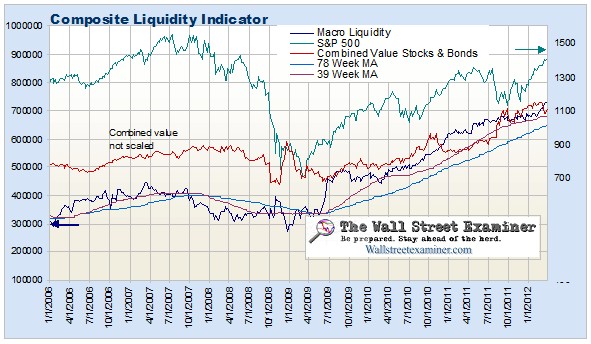According to Lee Adler's liquidity indicator, the stock market is not going to top out just yet; it's getting closer but weeks to months away.
Are you wondering whether the indicator is worth paying attention to? It is.
For example, on January 24, 2012, Lee wrote "Liquidity is Bullish is All" explaining why the trend was for higher stock prices. I quoted him in Stock World Weekly. (The full Jan. 22, Stock World Weekly is here.) Excerpt:
"A possible explanation for this week’s bullish run would be heightened expectations of an additional round of quantitative easing from the Fed (QE3). Rumors this week were pegging the size of the program to be as large as $1Tn. (Fed’s Latest Easing Could Cost $1 Trillion: Economists)…
"But perhaps most importantly, liquidity flows are positive. According to Lee Adler,
“Liquidity flows in the US branch of the system have been turning more bullish in recent weeks. Several indicators that had been neutral or bearish have turned bullish, joining deposit flows into the US banking system (apparently from EU) which have been the lead bullish sled dog for a while. In this liquidity based model of the market, there is no way the markets can decline as long as this continues.” (Liquidity is Bullish is All)
Cyclical Liquidity Flows Approach Inflection Point
Courtesy of Lee Adler of the Wall Street Examiner
The composite liquidity indicator was virtually flat last week on a mixed performance in its components. The indicator has recently accelerated upward away from its 39 week moving average. With demand for Treasuries slackening, the rise in liquidity has gone entirely to the benefit of the stock market and some commodities.
I would expect the indicator to develop a negative divergence before the stock market tops out ahead of the next major cyclical bear market. In the past, such divergences have developed at both tops and bottoms over periods of 4 to 6 months. If form holds this suggests that the top of this market is at least that far away, given that the indicator is still making new highs.
The Fed will contribute to a positive slope at least until August when the last MBS purchases should be settling. However, that positive influence will diminish over time as the level of mortgage refis recedes. The Fed will need to replace fewer MBS paydowns on its balance sheet, so it will be sending less cash to Primary Dealers. At the same time, it looks as though the ECB will stay on the sidelines for some time. That could reduce deposit flows into the US. On the other hand, a worsening of the European situation could send capital cascading toward the US. We'll just have to see how this develops in the weeks ahead.
Intermediate trend readings remain split between neutral and bullish. None of the components are bearish, so there's no apparent reason for an intermediate market reversal in stocks yet, especially with occasional bouts of selling in bonds freeing up cash for stock purchases.
However, that turn may not be too far off. Five of the 6 component indicator short term patterns are now either neutral or bullish. The one that is short term bearish, bank purchases of Treasuries and Agencies, is due for an intermediate downturn, based on historical patterns. A couple of others are also due for intermediate cyclical declines. They haven't happened yet, but given that turns are due, the composite could top out and begin a pullback over the next few weeks. That should coincide with a stock market correction.
The longer term direction of the indicator composite suggests that the stock market should continue to have a bullish tilt, while Treasuries, which are over-owned and still long term overbought, may continue to get hammered intermittently. All of the liquidity flows could be focused on stocks and commodities while the Treasury market sees occasional selling. That can only go on for so long however. Bond market downturns in the past have led stock market turns by about 3 months.
Copyright © 2012 The Wall Street Examiner. All Rights Reserved. This article may be reposted with attribution and a prominent link to the source The Wall Street Examiner.





